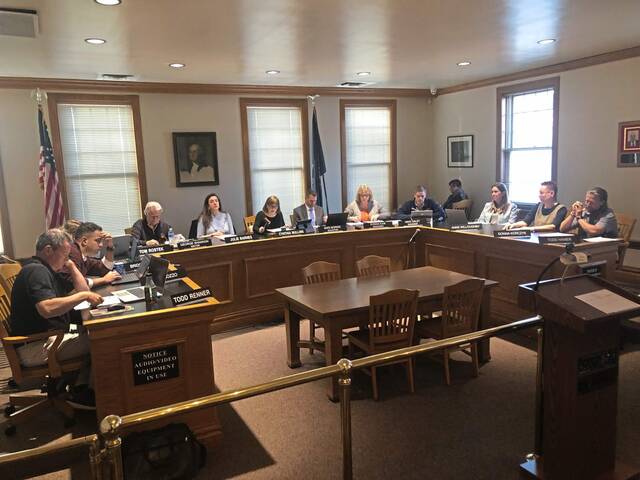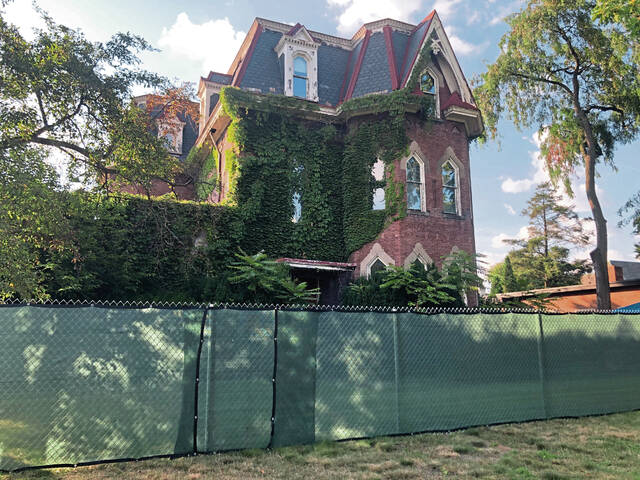Sewickley Council denies request to demolish historic Herbst House
An old convent and private residence in Sewickley that also once was used as a Catholic school will remain standing as borough leaders have rejected a demolition request.
Council voted 6-0 Tuesday night to stand by its historic review commission’s recommendation and not allow what is colloquially called the Herbst House to be knocked down.
“The structure is in the historic district, and it is governed by our historic review ordinance,” council president Cynthia Mullins said after the vote. “Since I’ve lived here, this community has demonstrated over the years that it values its historic districts and is committed to historic preservation. … It’s part of the unique character of Sewickley.”
The Divine Redeemer Parish submitted its demolition request last year. The historic review commissioners unanimously recommend its denial Aug. 1.
The parish includes St. James Church in Sewickley and St. Mary’s church in Aleppo.
The house was built in the late 1800s. It was owned by D.C. Herbst of the Independent Natural Gas Co. and Standard Oil Co.
The home was sold to the church in the early 1900s for $12,000. It became the first home of St. James School when it was dedicated on Dec. 6, 1913, according to church records.
The three-story mansion has been vacant for about three decades. It has deteriorated, primarily due to water leaking from the roof. Vegetation also reclaimed a portion of the property.
Councilman Tom Rostek recused himself from the vote after announcing he has been a member of the parish for the past 25 years.
Parish authorities argued that the structure was unsafe and in deplorable condition.
Prior to council’s vote, Catholic Diocese of Pittsburgh attorney Chris Ponticello reiterated those claims. He said the parish does not have the need nor the funds to repair the deteriorating building.
“We had our structural engineer go through the property on two different occasions with the conclusion that the property was not worth attempting to salvage,” Ponticello said. “We also talked about the parish needs as a faith community — did it have need for this property, and did it have the finances to bring forth any attempted restoration of this scope.”
Ponticello said the parish runs a $12,000 deficit weekly. It can’t afford utilities for the Herbst House — let alone come up with an estimated $3.7 million to restore it.
The borough plans to submit a written decision to the parish sometime this month.
Ponticello said he will take that decision to parish leaders to discuss its options.
“Obviously, we don’t agree with the decision of council,” Ponticello said. “I respect them. I respect their process. I think that the real difficulty here continues for the parish, that’s saddled with that building. You heard the estimated costs (for restoration). … We’re going to take some time and consider our options.”
Restoration talks
The parish and Pittsburgh History & Landmarks Foundation officials have been in talks for months about possible restoration efforts after council tabled taking action on the request in September.
Several residents, borough property owners and foundation officials spoke at the council meeting, all of whom were against the historic demolition.
“We don’t want Western Pennsylvania to lose such a historic structure,” foundation co-founder Arthur Ziegler Jr. told council.
Foundation president Michael Sriprasert said a partial restoration would cost about $2.5 million to restore the Herbst House facade and open its first floor.
“We have commitments today, without yet going out to publicly fund raise, of $300,000,” Sriprasert said. “At the very least, we can stabilize and replace that roof and stop it from deteriorating further. Plug that building up, and that will show action on the street and allow for fundraising beyond that time.”
Ponticello noted the parish did not receive an engineer’s report from the borough until the afternoon right before the meeting.
Borough engineer Mike Galet said after the meeting that his company’s report indicated the Herbst House could be saved. The report did not have restoration cost estimates.
“The foundation was in ‘OK’ shape,” Galet said. “We noted it was a salvageable structure overall. A lot of damage was attributed to the roof, itself, which caused water damage for the underlying joists.”
Galet said “significant cosmetic improvements” and other repairs would also need to be made.
Mullins said she hopes the parish and foundation will continue their restoration talks now that a vote was taken.
“I’m still very hopeful that Pittsburgh History & Landmarks, the local community of preservationists here in the Quaker Valley will continue to work through this with the parish,” Mullins said. “They will together collaborate to figure out a way to save this structure and make it useful for the parish.”
Speakers’ reaction
Historic review commissioner Teresa Duff said she was pleased with council’s decision to deny the demolition request.
“We are here to advise council, and I’m glad that they are taking our advice,” Duff said. “Hopefully the fact that we are about to embark on a historic cultural resource survey across the borough (was a factor in its decision).
“Preservation is a long game. I am hopeful they will stay the course and continue the trajectory toward measuring the inventory so we can manage it within the borough.”
Resident Heather Blane was also a speaker at the council meeting.
She said she has offered to purchase the property for years, but the parish never moved on her offers. She would like it to be restored to a single-family home.
“I am not going to stop trying until it no longer exists,” Blane said. “I will be at every meeting. I will be at every whatever. I will keep trying.”
Michael DiVittorio is a TribLive reporter covering general news in Western Pennsylvania, with a penchant for festivals and food. He can be reached at mdivittorio@triblive.com.
Remove the ads from your TribLIVE reading experience but still support the journalists who create the content with TribLIVE Ad-Free.



